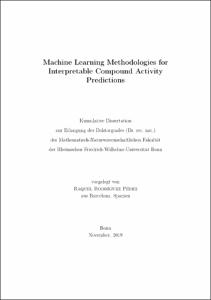Machine Learning Methodologies for Interpretable Compound Activity Predictions

Machine Learning Methodologies for Interpretable Compound Activity Predictions

| dc.contributor.advisor | Bajorath, Jürgen | |
| dc.contributor.author | Rodríguez Pérez, Raquel | |
| dc.date.accessioned | 2020-04-27T15:54:32Z | |
| dc.date.available | 2020-04-27T15:54:32Z | |
| dc.date.issued | 26.02.2020 | |
| dc.identifier.uri | https://hdl.handle.net/20.500.11811/8300 | |
| dc.description.abstract | Machine learning (ML) models have gained attention for mining the pharmaceutical data that are currently generated at unprecedented rates and potentially accelerate the discovery of new drugs. The advent of deep learning (DL) has also raised expectations in pharmaceutical research. A central task in drug discovery is the initial search of compounds with desired biological activity. ML algorithms are able to find patterns in compound structures that are related to bioactivity, the so-called structure-activity relationships (SARs). ML-based predictions can complement biological testing to prioritize further experiments. Moreover, insights into model decisions are highly desired for further validation and identification of activity-relevant substructures. However, the interpretation of complex ML models remains essentially prohibitive. This thesis focuses on ML-based predictions of compound activity against multiple biological targets. Single-target and multi-target models are generated for relevant tasks including the prediction of profiling matrices from screening data and the discrimination between weak and strong inhibitors for more than a hundred kinases. Moreover, the relative performance of distinct modeling strategies is systematically analyzed under varying training conditions, and practical guidelines are reported. Since explainable model decisions are a clear requirement for the utility of ML bioactivity models in pharmaceutical research, methods for the interpretation and intuitive visualization of activity predictions from any ML or DL model are introduced. Taken together, this dissertation presents contributions that advance in the application and rationalization of ML models for biological activity and SAR predictions. | en |
| dc.language.iso | eng | |
| dc.rights | In Copyright | |
| dc.rights.uri | http://rightsstatements.org/vocab/InC/1.0/ | |
| dc.subject.ddc | 004 Informatik | |
| dc.title | Machine Learning Methodologies for Interpretable Compound Activity Predictions | |
| dc.type | Dissertation oder Habilitation | |
| dc.publisher.name | Universitäts- und Landesbibliothek Bonn | |
| dc.publisher.location | Bonn | |
| dc.rights.accessRights | openAccess | |
| dc.identifier.urn | https://nbn-resolving.org/urn:nbn:de:hbz:5-57767 | |
| ulbbn.pubtype | Erstveröffentlichung | |
| ulbbnediss.affiliation.name | Rheinische Friedrich-Wilhelms-Universität Bonn | |
| ulbbnediss.affiliation.location | Bonn | |
| ulbbnediss.thesis.level | Dissertation | |
| ulbbnediss.dissID | 5776 | |
| ulbbnediss.date.accepted | 20.02.2020 | |
| ulbbnediss.institute | Mathematisch-Naturwissenschaftliche Fakultät : Fachgruppe Molekulare Biomedizin / Life & Medical Sciences-Institut (LIMES) | |
| ulbbnediss.fakultaet | Mathematisch-Naturwissenschaftliche Fakultät | |
| dc.contributor.coReferee | Fröhlich, Holger |
Files in this item
This item appears in the following Collection(s)
-
E-Dissertationen (4442)




